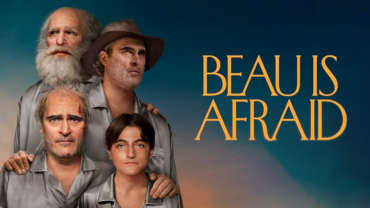“Beau Is Afraid” is a mesmerizing and captivating cinematic experience that delves into the depths of a boy’s fear of his own mother. Anchored by a stunning performance from Joaquin Phoenix, the film explores the intricate journey of a boy trapped in a graying body, suspended in a state of arrested development. Phoenix’s portrayal is nothing short of extraordinary, with his minute gestures and fragile voice capturing the essence of a child clinging to his mother’s nurturing embrace.
Ari Aster, the brilliant mind behind “Hereditary” and “Midsommar,” once again proves his prowess as both a writer and director. While his previous works revolved around the horror of relationships, “Beau Is Afraid” takes a darkly comedic approach, blending it with a surreal fantasy filled with mommy issues. It masterfully explores the notion of being condemned from birth and adds another layer of complexity to Aster’s filmography.
The film’s visual world-building is an enchanting spectacle, meticulously crafted by Aster and production designer Fiona Crombie. The downtown neighborhood where Beau resides is a violent and mad landscape, beautifully portrayed with a choreography of death and destruction. Cinematographer Pawel Pogorzelski’s long tracking shots paint a vivid picture of a sick, self-destructive society consuming itself in broad daylight.
Aster’s relentless sense of humor draws viewers into the absurd and claustrophobic developments of the narrative. From an angry neighbor persistently sliding notes about noise levels to the disorienting inconsistencies throughout the story, the film establishes a rhythm of dread that keeps audiences on edge. The most daunting moments arise from Beau’s phone calls with his mother, Mona Wassermann, portrayed with exquisite venom by Patti LuPone. These interactions amplify the tension, making Beau feel increasingly small and trapped. Phoenix’s exceptional close-ups during these conversations display his struggle to maintain composure, especially when confronted with devastating news about his mother.
Structured in various chapters of varying lengths and tones, “Beau Is Afraid” takes viewers through Beau’s fluctuating sense of security. After a traumatic meltdown, he finds himself injured and under the care of suburban parents played by Nathan Lane and Amy Ryan. They provide an eerie comfort, masking their own pain while attending to Beau’s needs. However, Beau’s ultimate goal remains to see his mother, and his encounters with the family’s resentful daughter Toni, portrayed by Kylie Rogers, intensify the bewilderment of his odyssey.
The film takes a daring turn midway through, immersing viewers in a stop-motion sequence directed by Cristóbal León and Joaquín Cociña. This captivating interlude serves as a movie-within-a-movie, tapping into the sentimental, hallucinatory, and poetic realms of Beau’s complex psyche. The animation not only adds to the film’s uncanniness but also becomes a metaphor for the lifelike nature of art and its profound connection to the human experience.
While “Beau Is Afraid” excels in many aspects, it does stumble in conveying tenderness with the same sincerity found in other elements of the film. Aster’s maximalist vision occasionally results in heavy-handed developments that diminish the intended heartfelt tragedy. Nevertheless, Zoe Lister-Jones delivers a colossal performance as Mona in the flashback scenes, providing insight into the character’s controlling nature while unraveling the source of Beau’s torment.
The film’s third act embraces its exploitation film roots, immersing audiences in a grand guignol of emotional and psychological trauma. It combines moments of terror, jaw-dropping absurdity, and a delicate interplay between past and present. While this sequence displays power and showcases fire-and-brimstone performances, it risks overwhelming viewers with its atonal nature and twists verging on self-parody. The relentless intensity may lead to numbing, diluting the impact of the intricate yet chaotic arrangement.
“Beau Is Afraid” features a wealth of surprising performances from actors such as Parker Posey, Denis Ménochet, and Stephen McKinley Henderson, who thrive in the film’s off-kilter environment. However, it is Ari Aster himself who emerges as the most crucial figure in the film. With this ambitious project, he fearlessly confronts his own artistic identity, seamlessly integrating elements from his previous works. The personal nature of “Beau Is Afraid” is palpable, as Aster’s exploration of horrific relationships and fixation on themes like head trauma and communes becomes intensely personal through the use of first-person point-of-view shots and thought-provoking bookending scenes.
“Beau Is Afraid” demands multiple viewings to fully appreciate its intricacies, much like Aster’s previous films. The skill with which he reveals the plot’s layers and manipulates audience perceptions adds to his status as an exceptional entertainer. The film’s ambitious nature shines through, highlighting Aster’s refusal to create anything lazy or overly self-assured. After experiencing the dizzying and unforgettable journey of “Beau Is Afraid,” viewers will undoubtedly appreciate and applaud Aster’s remarkable talent.
(Note: This review is based on the author’s first viewing of the movie, acknowledging that Aster’s works often reveal further intricacy upon subsequent viewings.)

